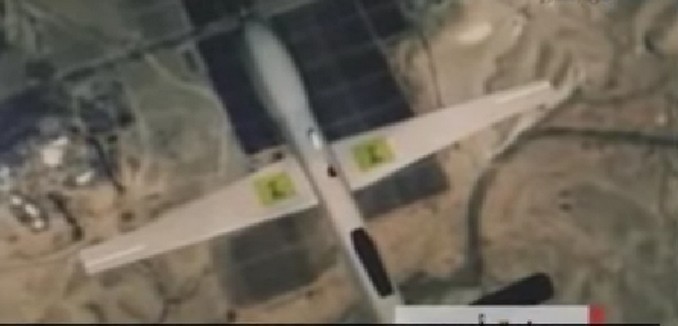IHS Jane’s, the leading publisher of defense information, has located a drone base operated by Hezbollah in northern Lebanon, Armin Rosen of Business Insider reported today.
The airstrip includes a 2200-foot unpaved runway, several outbuildings, and an antenna that “could potentially be used to extend the range of a UAV ground control station.” (It can be found at 34.3109624, 36.3492857 on Google Maps).
As the Jane’s report notes, the airstrip is too short to accommodate most manned aircraft, while its unpaved surface and mountainous surrounding terrain make it largely off-limits to planes that technically capable of landing on a runway of its length. That means there’s a strong possibility it was “built for Iranian-made UAVs, including the Ababil-3, which has been employed over Syria by forces allied to the Syrian regime, and possibly the newer and larger Shahed-129.”
The Ababil-3 is a small reconnaissance drone with limited range and flight endurance; it’s also been deployed by the Sudanese armed forces in the former Iranian ally’s various civil conflicts. But as The Aviationist notes, the Shahed-129 is superficially similar in design to the US’s Reaper and Predator platforms, and Iranian military officials claim that the drone can carry as many as 8 Sadid missiles.’
According to IHS Jane’s, the airstrip was built between early 2013 and the middle of 2014. It is possible that drones could have played a role in the decisive battle for Qusayr in 2013. Syrian forces loyal to President Bashar al-Assad and backed by Hezbollah captured the strategic city in June 2013. Rosen also pointed out that the city of Homs, which was recaptured by Syrian forces last year, is in range of drones operating out of the secret location.
Rosen added that the drone base also suggests “that Iranian Revolutionary Guards Corps or other Iranian personnel are assisting them.”
A January airstrike against a convoy in southern Syria, believed to have been carried out by Israel, killed a top Hezbollah commander and an Iranian general, showing the close cooperation between Iran and its proxy closer to Israel’s border.
In Meet the Proxies: How Iran Spreads its Empire Through Terrorist Militias, which was published in the March 2015 issue of The Tower Magazine David Daoud observes:
But while the Houthis have made the most recent noise, Iran has been using proxies to dominate other countries since the 1980s. Lebanese militia-cum-political party Hezbollah remains the most successful and most prominent Iranian revolutionary export. Indeed, Gilbert Achcar of the University of London has called it “the most prestigious member of the regional family of Khomeinism.” The Lebanon-based terrorist group is cut from the same ideological cloth as the Islamic Republic, which, according to former CIA intelligence analyst Kenneth Pollack, is Hezbollah’s model and inspiration. Eitan Azani, the deputy executive director of the Institute for Counter-Terrorism at IDC Herzliya, has said that Khomeini and his successors serve as Hezbollah’s ultimate source of religious, political, and ideological guidance and authority. Hezbollah fully accepts the concept of Absolute Wilayat al-Faqih, and openly acknowledges Khomeini as its faqih, leading Augustus Richard Norton of Boston University to call Khomeini Hezbollah’s “undisputed, authoritative leader.”
Hezbollah itself acknowledged this fact in their 1985 Open Letter, stating, “We obey the orders of one leader, wise and just, that of our tutor and faqih, who fulfills all of the necessary conditions: Ruhollah Musawi Khomeini.” With the death of Khomeini, Hezbollah did not end its submission to Iranian authority, but reaffirmed its allegiance to the current Supreme Leader, Ayatollah Khamenei. Hezbollah leader Hassan Nasrallah himself declared in May of 2008 that he was “proud of being a member of the Wilayat al-Faqih party.”
Hezbollah’s connection to Iran is not limited to professions of ideological fealty. In his book Deadly Connections, Daniel Byman, Research Director of the Brookings Institution’s Center for Middle East Policy, notes that Hezbollah does not only accept the concept of Absolute Wilayat al-Faqih in a general sense, but also subscribes to Iran’s particular worldview and its enmity toward the United States and Israel. Hezbollah’s implementation of its Islamist strategy is closely linked to Iran’s policy of exporting the Islamic Revolution abroad while consolidating and expanding it at home. In effect, this makes Hezbollah an arm of Iranian foreign policy. Indeed, Hezbollah has repeatedly fought wars that, in effect, solely benefited Iran. Whether combatting Israel, participating in the Syrian civil war, or sending its militants to Iraq, Hezbollah is at the service of its masters, often at the expense of its own, or Lebanon’s, interests.
Hezbollah is unquestionably the most prominent Iranian proxy on the international scene, having carried out a series of attacks abroad through what Matthew Levitt, Director of the Stein Program on Counterterrorism at the Washington Institute for Near East Policy, has called “Hezbollah’s international terrorist wing.” Known alternatively as the Islamic Jihad Organization or External Services Organization, it has received strong support from the IRGC and Iran’s Ministry of Intelligence. But perhaps the most telling example of the close relationship between Iran and Hezbollah is that Hezbollah has also operated within Iran itself, reportedly helping the regime to crush internal dissent. Indeed, Hezbollah sent approximately 5,000 of its fighters to participate in the suppression of the “Green Revolution” in 2009.
[Photo: Monitor Mideast / YouTube ]




